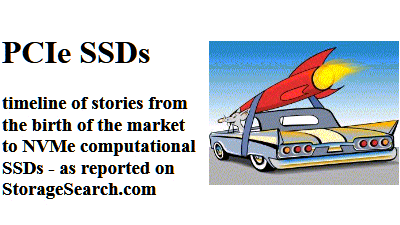 |
| ..... |
SSDs replacing HDDs?

that's
not exactly the way it happened
by Zsolt Kerekes,
editor - StorageSearch.com
It
irks me to see articles on the web which talk glibly about "SSDs
replacing hard drives" - because that's a gross simplification. It's wrong
- and shows ignorance about the rational and compelling reasons that people
buy SSDs.
For example SSDs can replace servers - not just replace
storage (SSD CPU
Equivalency) and since
2014
(key SSD idea #3 - random access memory doesn't have to be RAM) we've seen
growing evidence that flash SSDs will also replace most of the traditional
demand for DRAM too.
| |
What has actually been happening in the
history of
the SSD market is that in some applications the
user value
propositions for using SSDs provided different compelling reasons to adopt
SSDs in some market segments (particularly
in the enterprise) years before SSD adoption made sense in others. (See
who's who in storage
market research - for more data.)
Server
acceleration and
ruggedized environments (industrial and
military) are the
oldest reasons - for SSD adoption going back more than 2 decades in "getting
the job done at any cost" applications.
But it wasn't a
smooth ride for early SSD pioneers.
Instead the SSD accelerator market was patchy and discontinuous
throughout the 1980s and 1990s - with fast SSD products randomly appearing
and soon after disappearing - because the other ways of speeding up apps got
better too - and scaled better than early SSDs. (Those early SSD killers were
faster CPUs, commodity parallel processing - which later became multi-core
CPUs, wider CPU and RAM busses - 8, 16, 32, 64, 128, and 256 bit wide RAM
busses, arrays of disks - better known today as
RAID, and even
faster
RPM hard disks - until 2000.)
The economic arguments for SSD
server acceleration started changing 10 years ago from going faster at
high cost to actually costing less - by using less servers in some
high-end SSD accelerated apps. Then, through the 2000 to 2005 years as
flash got cheaper
and
HDDs got bigger (but not
any faster) we saw the
floor price factor
sweep low capacity flash SSDs into embedded systems - because low capacity SSDs
actually did cost
less than the lowest capacity hard drives.
Reliability in long
life systems was another factor which opened business doors to SSDs in the
2005 or so era - because the cost of replacing
failed cheap HDDs
outweighed the initial higher cost of reliable SSDs.
From where we are
today - there is high confidence in the SSD industry that 100% of new online
storage drives in the enterprise will be solid state in the datacenter in the
2016 to
2020
period.
The slowest switch-off from hard drives will take place in
the consumer PC
market - simply because many common PC entertainment apps - don't need the
performance of SSDs - whereas they do need high capacity. And although we're
now 10 years into the modern era of the
notebook SSD
market - many early products were disappointing - which has made consumers
wary of SSD promises. Eventually all storage will be solid state - but not
because solid state storage media hits cost parity with magnetic media. It will
happen even if hard disk storage is given away free - because hard drives won't
be able to deliver the application performance or the densities needed in
future systems.
M.2
SSDs
SSD news
SSD history
SSD market analysts
popular SSD
articles and blogs
. |
 |
. |
|
|
Much has been written about solid state
disks (SSDs) becoming the
next big thing in the IT
industry. But as to whether or not we have enough knowledge of how it will
revolutionize
the industry is a different question. How much do we really
know about
SSDs? If we are to ask people on the streets, it wouldn't come as a surprise
that they don't know much of what an SSD is. Even if they do know, most probably
it would be limited to a
USB pen drive, a
CompactFlash or a Secure Digital card, which are more on the consumer side of
the storage industry.
Technically speaking, they are not wrong. Most web definitions
describe an
SSD as a high-performance plug-and-play storage device that contains no
moving parts. Therefore, given that most of the aforementioned mobile disk
storage devices contain no movable parts, they can certainly be categorized as
SSDs.
But then again, there's more to SSDs than being a non-volatile device.
The purpose of this article is to give readers a clearer picture of what an SSD
is, its usage as well as its difference when pitted against the predominant data
storage device at present - the
hard disk drive (HDD).
More than its non-volatility, this article will reveal how much potential SSDs
have in optimizing the performance of the computing system.
SSD Defined
Here are several ways the SSD is defined.
From
the article in the SPARC
Product Directory -
Solid State Disks
- intro, applications & FAQs
"A solid state disk (SSD) is electrically, mechanically and software
compatible with a conventional (magnetic) hard disk or winchester. The
difference is that the storage medium is not magnetic (like a hard disk) or
optical (like a CD) but solid state semiconductor such as battery backed RAM,
EPROM or other electrically erasable RAMlike chip. This provides faster access
time than a disk, because the data can be randomly accessed and does not rely on
a read/write interface head synchronising with a rotating disk. The SSD also
provides greater physical resilience to physical vibration, shock and extreme
temperature fluctuations. The only downside is a higher cost per megabyte of
storage."
|
|
From the
webopedia SSD
article
"Abbreviated SSD, a solid state disk is a high-performance
plug-and-play storage device that contains no moving parts. SSD components
include either DRAM or flash memory boards, a memory bus board, a CPU, and a
battery card. Because they contain their own CPUs to manage data storage, they
are a lot faster (18MBps for SCSI-II and 44MBps for
UltraWide SCSI
interfaces) than conventional rotating hard disks ; therefore, they produce
highest possible I/O rates. SSDs are most effective for server applications and
server systems, where I/O response time is crucial. Data stored on SSDs should
include anything that creates bottlenecks, such as databases, swap files,
library and index files, and authorization and login information."
For the rest of this particular article, we will compare the
HDDs and
Flash-based SSDs. The
latter are the most popular type of SSDs employed by the military, aerospace,
industrial and
embedded systems industries.
(Editor's note -
RAM based SSDs - used for
server acceleration are an alternative technology - and can run faster than
flash - but are unsuitable for mobile or embedded applications.) |
|
Mortality Rate
Hard disk failure is a common occurrence in this age of
desktops and notebooks.
A lot of horror
stories have been told, passed around and even published about how valuable
data was lost and the agony of trying to
retrieve or at least
save a portion of the crashed hard drive. It is during this time that people
wonder,
why
do hard disks fail?
The reason is simple - wear and tear. Just like any good old machine
with mechanical components, HDDs tend to deteriorate over time. HDDs consist of
rotating, magnetically coated disks, known as platters, that are used to store
data. This rotating motion of the mechanical arms results in much wear and tear
after long periods of use. The operational lifespan of a computer HDD is
typically over three years .
A Flash-based SSD is different. Although the most common Flash chips
have around 300,000 write cycles, the best Flash chips are rated at 1,000,000
write cycles per block. On top of that, Flash SSD manufacturers employ different
ways to increase the longevity of the drives. In some cases, they use a "balancing"
algorithm to monitor the number of times each disk block has been written, which
greatly extends the operational lifespan of the drive. Furthermore, these
manufacturers also designed special "wear-leveling"
algorithms where once a certain percentage threshold for a given block is
reached, the SSD
controller will swap the data in that block with the data in another block
that has exhibited a "read-only-like" characteristic in the
background. This reduces performance lag and avoids further wearing off of the
blocks and thrashing of the disk. Even with usage patterns of writing/reading
gigabytes per day, a Flash-based SSD should last several years, depending on its
capacity. Add to that the inclusion of a
DRAM cache in
the disk architecture that further enhances its operational capabilities as well
as lifespan.
(Editor's note see also:-
article:-
Increasing Flash Solid State Disk Reliability - which discusses the
effectiveness of different wearout reduction algorithms built into SSD
products). |
|
Speeding Up
With the very
fast paced lifestyle these days, most businesses are time-bound and cannot
afford a slowing down in their transactions. This makes speed of HDDs a crucial
point in technological purchases. The typical access time for a Flash based SSD
is about 35 - 100 micro-seconds, whereas that of a rotating disk is around 5,000
- 10,000 micro-seconds. That makes a Flash-based SSD approximately 100 times
faster than a rotating disk.
This however raises another point -
what's the benefit of a high-speed SSD when the entire system cannot support it?
The evolution of CPUs in terms of performance has far surpassed the development
of the data storage system. The HDD is actually limiting the potential
of a computer system when they are not able to keep up with the performance of
the other components, particularly the CPU. If an HDD is replaced by a
high-speed SSD, the performance would significantly improve. The resulting
system would be a high-powered set-up that can go beyond the demands of
high-speed business or military environments.
Size Matters
To be a true plug-in replacement for
HDDs, Flash-based SSDs are manufactured in standard
2.5" and
3.5" form factors.
2.5" SSDs are normally used in laptops or notebooks while the 3.5"
form factors are used in desktops, or in
JBOD or other
SAN/NAS/DAS configurations. They
can often be used to replace traditional disks in storage arrays or in a
server's internal disk bays.
Flash-based SSDs
certainly fit the storage needs of most embedded systems that require much
smaller form factors.
Reliability
In terms of reliability, conventional
HDDs pale when compared to SSDs. The absence of mechanical arms and spinning
platters is the reason behind its
reliability. In
demanding environments, SSDs provide the type of ruggedness required for mobile
applications. Unlike the HDD, SSD's can withstand extreme shock and vibration
with data integrity and without any danger of data loss. This feature is very
important in industrial applications where exposure to highly combustible
materials and electromagnetic radiation are typical. Their ability to deliver
unnerving performance in extreme conditions also makes SSD play a vital role in
military operations, be it in defense, aerospace or aviation applications.
Military applications
require, in most cases, an operating temperature range of -60°C to +95°C.
Shock, vibration, and temperature ratings of HDDs cannot comply with military
standards, only SSDs can.
Power Play
In addition to speed, reliability and
mortality rate being positively affected by the SSD's non-volatility, they also
consume much less power than traditional HDDs. No additional power is required
to activate the platters or the mechanical arms present in most HDDs. Its power
consumption is practically only a fraction of a hard disk drive.
Heat Dissipation
Along with the lower power
consumption, there is also much lesser heat dissipation for systems using
Flash-based SSDs as their data storage solution. This is due to the absence of
heat generated from the rotating/movable media. This certainly proves to be the
one of the main advantages of Flash-based SSDs relative to that of a traditional
HDD. With less heat dissipation, it serves as the ideal data storage solution
for mobile systems such as PDAs, notebooks, etc. Users can do away with large
cooling fans, internal power supply and batteries for large storage arrays in
storage area networks.
(Editor's note:- an
earlier article
by BiTMICRO shows how the size and power advantages of flash SSDs could benefit
Blades in server farms.) |
|
|
Cost Considerations
Of course, everything
comes with a price.
Based on a cost-benefit logic, it is but expected that something with very
impressive features be priced higher than something that offers fewer benefits.
SSDs as being a bit more pricey than the traditional hard disk drive may be one
of the compelling reasons why up to now it hasn't gained as much popularity as
it should be getting with all its brilliant functions.
While the use of SSDs today have mostly been limited to industrial and
military implications, enterprise are now looking closely at SSDs for
implementing tiered storage and optimizing their storage architectures.
To
quote from the Solid
State Disks Buyers Guide published by
STORAGEsearch.com
|
"In fact the SSD is replacing servers and software licenses. SSDs can
be used either to speed up the response time of existing applications as an
alternative to buying more servers, or to reduce the number of servers and
software licenses deployed. The economics can be compellingly in favor of an SSD
deployment".
The industry is also expecting more breakthroughs as higher
memory capacities and faster performance are now being produced for a wider
array of choices fit for any mission-critical application.
Analysts
foresee a rapidly closing gap between HDD and flash SSD pricing (see related
article by Marius Tudor, BiTMICRO Networks -
"Are
Flash Solid-State Disks Ready for the Enterprise" ).
This
vision is also bolstered by a recent announcement (July 2005) of electronic
giant Samsung that they
will invest heavily in improving their flash and DRAM production lines and flash
SSD equipped laptops. Only time will tell if we will witness widespread
commercial adoption of SSDs.
...BiTMICRO Networks
profile
Editor's afterword:- the above article was published here in
August 2005
but remains popular.
For more SSD articles take a look at these
directories.
|
| . |
| |
|
|
|
.. |
|
 |
|
.. |
|
| the varied
futures of enterprise data storage? |
| Here are some articles written
at different times and with different contextual assumptions.
| | |
| ... |
... |
|
|
|
... |
|
|
|
... |
|
|
| ... |
|
|
 |
|
. |
|
| how fast can your
SSD run backwards? |
SSDs are complex devices and there's a
lot of mysterious behavior which isn't fully revealed by benchmarks, datasheets
and whitepapers.
Underlying all the important aspects of SSD behavior
are
asymmetries
which arise from the intrinsic technologies and architecture inside the SSD.
|
|
| | |
|
. |
|
| Surviving SSD
sudden power loss |
Why should you care
what happens in an SSD when the power goes down?
This important design
feature - which barely rates a mention in most SSD datasheets and press releases
- has a strong impact on
SSD data integrity
and operational
reliability.
This article will help you understand why some
SSDs which (work perfectly well in one type of application) might fail in
others... even when the changes in the operational environment appear to be
negligible. |
|
| | |
|
. |
|
Do
you understand all the ingredients in the SSD news headlines?
This
might help. |
... |
 | | |
|
. |
|
| SSDs and HDDs - how things
changed in the 10 years from 2000 to 2010 |
- Hard disk capacity grew 5x in the period
2000 to 2009.
3.5" HDDs went from 180GB to 2TB.
- flash SSD random
IOPS -
(in 2.5" / 3.5" drives) grew 100x in the period 2000 to 2010
while HDD random
IOPS
remained exactly the same.
| | |
| . |
| "Now whether a server
company hates or loves Fusion-io - they have all become hostages to the idea
that they absolutely have to offer some kind of supported SSD style of
acceleration. They no longer have any choice in the matter." |
| hostage to the
fortunes of SSD | | |
| . |
| the flash
SSD story - survival of the fittest? |
The
emerging size of
the flash SSD market as you see it today was by no means inevitable. It owes a
lot to 3 competing storage media competitors which failed to evolve fast enough
in the Darwinian jungle of the storage market in the
past decade.
One of these 3 contenders is definitely on the road to extinction -
but could one of the other 2 still emerge to threaten flash SSDs?
A
recently published article -
SSD's past phantom
demons explores the latent market threats which hovered around the flash SSD
market in the past decade. They seemed real and solid enough at the time. |
 |
Getting a realistic
perspective of flash SSD's past demons (which seemed very threatening at the
time) may help you better judge the so-called "new" generation of nv
memory contenders - which are also discussed in the article. ...read the article | | | |
| . |
|
| . |
|
|
| . |
| |
|
|
|
|
|
|
|
|
|
|
|
. |
|
| "...One size does
not fit all in the SSD world. ... SSDs are not simply a faster version of
HDDs. If SSDs performance characteristic doesn't match data access patterns,
SSDs will not perform as expected and sometimes
can be slower than HDDs." |
| ...Eric Kao,
Chairman and CEO - Memoright
- in his presentation -
the
Age of Application-Specific SSDs (pdf) at the Flash Memory Summit (August
2011) | | | |





